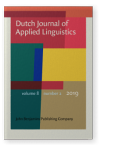Vol. 8:2 (2019) ► pp.270–290
The effect of task modality and discourse mode on EFL learners’ narrative task performance
This study examined the effect of task mode (written vs. spoken) and discourse mode (pair vs. individual) on advanced Iranian EFL learners’ task performance. Participants, four groups of advanced learners, performed a narrative task in four conditions: the first group of participants performed the task individually in a spoken mode, the second group performed the task individually in a written mode, the third group performed the task in pairs in a spoken mode, and the participants in the fourth group performed the task in pairs in a written mode. The results indicated that the participants’ performances, in terms of complexity, accuracy, and fluency improved greatly among learners who worked in pairs rather than individually, and those who performed written tasks rather than oral ones.
Article outline
- 1.Introduction
- 2.Review of the literature
- 2.1Collaborative vs. individual task performance
- 2.2Written vs. spoken task performance
- 3.Method
- 3.1Participants
- 3.2Materials
- 3.3Measures
- 3.4Procedure
- 4.Results
- 5.Discussion
- 6.Conclusion
- 7.Pedagogical implications
- 8.Limitations of the study
-
References
For any use beyond this license, please contact the publisher at [email protected].
